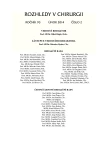-
Medical journals
- Career
Evaluation of safe margins in pathology examination in breast oncosurgery
Authors: M. Trnková
Authors‘ workplace: BIOLAB Praha, k. s., ředitelka: MUDr. M. Trnková
Published in: Rozhl. Chir., 2014, roč. 93, č. 2, s. 107-111.
Category: Various Specialization
Práce je určena k postgraduálnímu vzdělávání lékařů.
Overview
In recent years breast-conserving therapy has become the most frequently used therapy for early stages of breast cancer. The complete excision of a tumour using this protocol is a statistically significant parameter which influences the incidence of local recurrence and overall survival. Evaluation of the completeness of the resection and especially the distance of the tumour from the margins of the lumpectomy, however, brings a number of problems which arise not only from the character of the tissue with a majority of adipose stroma, but also from the character of the tumour tissue itself regarding growth pattern and multifocality. In fact, establishing the dimension of the margins which we consider safe, remains rather controversial.
In this article we discuss contemporary views on the free or safe margins evaluation and summarise technical possibilities for examination of the resection margins in mammary oncosurgery.Key words:
breast carcinoma – breast-conserving surgery – resection margins
Sources
1. Lakhani SR, Ellis IO, Schnitt SJ, et al. WHO Classification of Tumours of the Breast, 4th edition 2012.
2. Veronesi U, et al. Twenty-year follow-up of a randomized study comparing breast-conserving surgery with radical mastectomy for early breast cancer. New England Journal of Medicine 2002;16 : 1227–1232.
3. Houssami N, MacAskill P, Marinovich ML, et al. Metaanalysis of the impact of surgical margins on local recurrence in women with early-stage invasive breast cancer treated with breast-conserving therapy. European Journal of Cancer 2010;18 : 3219 – 3232.
4. Corsi F, Sorrentino L, Bossi D, Sartani A, Foschi D. Preoperative Localization and Surgical Margins in Conservative Breast Surgery. International Journal of Surgical Oncology 2013; Epub 2013 Aug 5 http://dx.doi.org/10.1155/2013/793819.
5. Gulcelik MA, Dogan L, Yuksel M, Camlibel M, Ozaslan C, et al. Comparison of outcomes of standard and oncoplastic breast-conserving surgery. The Breast Journal 2013;1 : 56–63.
6. Krekel NM et al. Is breast specimen shrinkage really a problem in breast-conserving surgery? Journal of Clinical Pathology 2012;3 : 224–7.
7. Russo AL, et al. Margin status and the risk of local recurrence in patients with early-stage breast cancer treated with breast-conserving therapy. Breast Cancer Research and Treatment 2013;7 : 353–61
8. Ananthakrishnan P. Optimizing Surgical Margins in Breast Conservation. International Journal of Surgical Oncology 2012; Epub 2012 Dec 9 http://dx.doi.org/10.1155/2012/585670
9. Schwartz GF. Consensus Conference Committee Journal of the American College of Surgeons 2006;2 : 198–207.
10. Margenthaler JA, Gao F, Klimberg VS. Margin index: a new method for prediction of residual disease after breastconserving surgery. Annals of Surgical Oncology 2010;10 : 2696–2701.
11. Haloua MH, Krekel NM, Winters HA, Rietveld DH, et al. A systematic review of oncoplastic breast-conserving surgery: current weaknesses and future prospects. Annals of Surgery 2013; 4 : 609–20.
12. Emmadi R, Wiley EL. Evaluation of Resection Margins in Breast Conservation Therapy: The Pathology Perspective – Past, Present, and Future. International Journal of Surgical Oncology 2012;Epub 2012 Nov 19 http://dx.doi.org/10.1155/2012/180259.
13. Wood WC. Close/positive margins after breast-conserving therapy: Additional resection or no resection? The Breast 2013;22 : 115–117.
Labels
Surgery Orthopaedics Trauma surgery
Article was published inPerspectives in Surgery

2014 Issue 2-
All articles in this issue
- Ten years of endovenous ablation – achievements, failures and future
- Chemoembolization with Drug Eluting Beads (TACE DEB) in patients with primary unresectable hepatocellular carcinoma (HCC)
- Clostridium colitis at a surgical department
- The use of acellular biological xenografts in local treatment of Lyell’s syndrome
- The use of telemetric intracranial pressure monitoring in the differential diagnosis of idiopathic intracranial hypertension – a case report
- Evaluation of safe resection margins in rectal carcinoma
- Evaluation of safe resection margins in tumours of parenchymatous organs
- Evaluation of safe margins in pathology examination in breast oncosurgery
- Perspectives in Surgery
- Journal archive
- Current issue
- Online only
- About the journal
Most read in this issue- Evaluation of safe resection margins in tumours of parenchymatous organs
- Evaluation of safe resection margins in rectal carcinoma
- Evaluation of safe margins in pathology examination in breast oncosurgery
- Clostridium colitis at a surgical department
Login#ADS_BOTTOM_SCRIPTS#Forgotten passwordEnter the email address that you registered with. We will send you instructions on how to set a new password.
- Career

